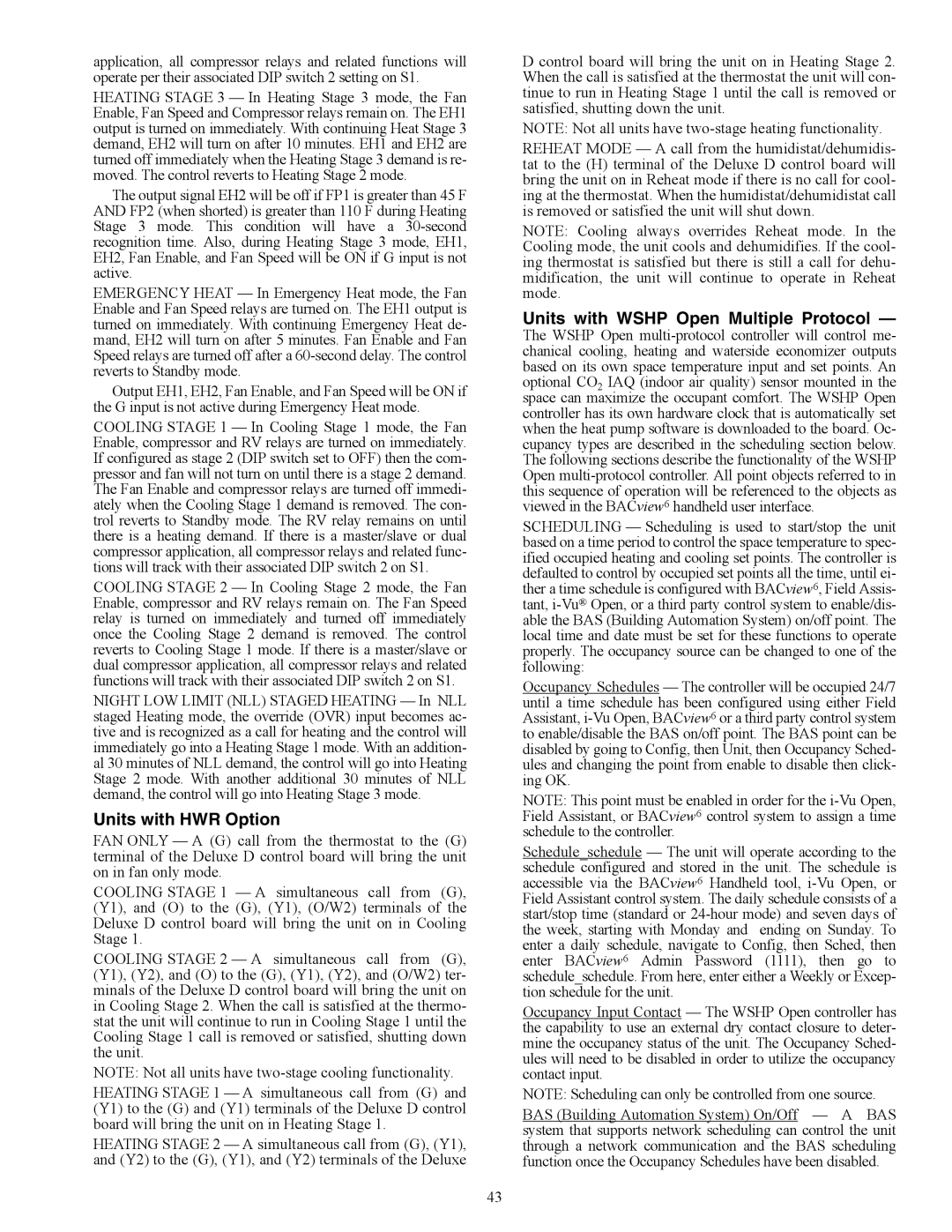application, all compressor relays and related functions will operate per their associated DIP switch 2 setting on S1.
HEATING STAGE 3 — In Heating Stage 3 mode, the Fan Enable, Fan Speed and Compressor relays remain on. The EH1 output is turned on immediately. With continuing Heat Stage 3 demand, EH2 will turn on after 10 minutes. EH1 and EH2 are turned off immediately when the Heating Stage 3 demand is re- moved. The control reverts to Heating Stage 2 mode.
The output signal EH2 will be off if FP1 is greater than 45 F AND FP2 (when shorted) is greater than 110 F during Heating Stage 3 mode. This condition will have a
EMERGENCY HEAT — In Emergency Heat mode, the Fan Enable and Fan Speed relays are turned on. The EH1 output is turned on immediately. With continuing Emergency Heat de- mand, EH2 will turn on after 5 minutes. Fan Enable and Fan Speed relays are turned off after a
Output EH1, EH2, Fan Enable, and Fan Speed will be ON if the G input is not active during Emergency Heat mode.
COOLING STAGE 1 — In Cooling Stage 1 mode, the Fan Enable, compressor and RV relays are turned on immediately. If configured as stage 2 (DIP switch set to OFF) then the com- pressor and fan will not turn on until there is a stage 2 demand. The Fan Enable and compressor relays are turned off immedi- ately when the Cooling Stage 1 demand is removed. The con- trol reverts to Standby mode. The RV relay remains on until there is a heating demand. If there is a master/slave or dual compressor application, all compressor relays and related func- tions will track with their associated DIP switch 2 on S1.
COOLING STAGE 2 — In Cooling Stage 2 mode, the Fan Enable, compressor and RV relays remain on. The Fan Speed relay is turned on immediately and turned off immediately once the Cooling Stage 2 demand is removed. The control reverts to Cooling Stage 1 mode. If there is a master/slave or dual compressor application, all compressor relays and related functions will track with their associated DIP switch 2 on S1.
NIGHT LOW LIMIT (NLL) STAGED HEATING — In NLL staged Heating mode, the override (OVR) input becomes ac- tive and is recognized as a call for heating and the control will immediately go into a Heating Stage 1 mode. With an addition- al 30 minutes of NLL demand, the control will go into Heating Stage 2 mode. With another additional 30 minutes of NLL demand, the control will go into Heating Stage 3 mode.
Units with HWR Option
FAN ONLY — A (G) call from the thermostat to the (G) terminal of the Deluxe D control board will bring the unit on in fan only mode.
COOLING STAGE 1 — A simultaneous call from (G), (Y1), and (O) to the (G), (Y1), (O/W2) terminals of the Deluxe D control board will bring the unit on in Cooling Stage 1.
COOLING STAGE 2 — A simultaneous call from (G), (Y1), (Y2), and (O) to the (G), (Y1), (Y2), and (O/W2) ter- minals of the Deluxe D control board will bring the unit on in Cooling Stage 2. When the call is satisfied at the thermo- stat the unit will continue to run in Cooling Stage 1 until the Cooling Stage 1 call is removed or satisfied, shutting down the unit.
NOTE: Not all units have
HEATING STAGE 1 — A simultaneous call from (G) and (Y1) to the (G) and (Y1) terminals of the Deluxe D control board will bring the unit on in Heating Stage 1.
HEATING STAGE 2 — A simultaneous call from (G), (Y1), and (Y2) to the (G), (Y1), and (Y2) terminals of the Deluxe
D control board will bring the unit on in Heating Stage 2. When the call is satisfied at the thermostat the unit will con- tinue to run in Heating Stage 1 until the call is removed or satisfied, shutting down the unit.
NOTE: Not all units have
REHEAT MODE — A call from the humidistat/dehumidis- tat to the (H) terminal of the Deluxe D control board will bring the unit on in Reheat mode if there is no call for cool- ing at the thermostat. When the humidistat/dehumidistat call is removed or satisfied the unit will shut down.
NOTE: Cooling always overrides Reheat mode. In the Cooling mode, the unit cools and dehumidifies. If the cool- ing thermostat is satisfied but there is still a call for dehu- midification, the unit will continue to operate in Reheat mode.
Units with WSHP Open Multiple Protocol —
The WSHP Open
SCHEDULING — Scheduling is used to start/stop the unit based on a time period to control the space temperature to spec- ified occupied heating and cooling set points. The controller is defaulted to control by occupied set points all the time, until ei- ther a time schedule is configured with BACview6, Field Assis- tant,
Occupancy Schedules — The controller will be occupied 24/7 until a time schedule has been configured using either Field Assistant,
NOTE: This point must be enabled in order for the
Schedule_schedule — The unit will operate according to the schedule configured and stored in the unit. The schedule is accessible via the BACview6 Handheld tool,
Occupancy Input Contact — The WSHP Open controller has the capability to use an external dry contact closure to deter- mine the occupancy status of the unit. The Occupancy Sched- ules will need to be disabled in order to utilize the occupancy contact input.
NOTE: Scheduling can only be controlled from one source.
BAS (Building Automation System) On/Off — A BAS system that supports network scheduling can control the unit through a network communication and the BAS scheduling function once the Occupancy Schedules have been disabled.
43
